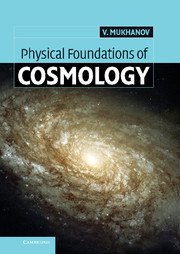Book contents
- Frontmatter
- Contents
- Foreword by Professor Andrei Linde
- Preface
- Acknowledgements
- Units and conventions
- Part I Homogeneous isotropic universe
- 1 Kinematics and dynamics of an expanding universe
- 2 Propagation of light and horizons
- 3 The hot universe
- 4 The very early universe
- 5 Inflation I: homogeneous limit
- Part II Inhomogeneous universe
- Bibliography
- Index
2 - Propagation of light and horizons
from Part I - Homogeneous isotropic universe
Published online by Cambridge University Press: 05 September 2012
- Frontmatter
- Contents
- Foreword by Professor Andrei Linde
- Preface
- Acknowledgements
- Units and conventions
- Part I Homogeneous isotropic universe
- 1 Kinematics and dynamics of an expanding universe
- 2 Propagation of light and horizons
- 3 The hot universe
- 4 The very early universe
- 5 Inflation I: homogeneous limit
- Part II Inhomogeneous universe
- Bibliography
- Index
Summary
We obtain most of the information about the universe from light. Over the last century, the development of x-ray, radio and infrared detectors has given us new windows on the universe. Understanding the propagation of light in an expanding universe is therefore critical to the interpretation of observations.
Problem 2.1 Estimate the total amount of energy received by all optical telescopes over the course of the last century and compare this energy to that needed to return this book to your bookshelf.
There is a fundamental limit to how far we can see, since no particles can travel faster than light. The finite speed of light leads to “horizons” and sets an absolute constraint on our ability to comprehend the entire universe. The term “horizon” is used in different contexts in the literature, often without clear definition, and one of the purposes of this chapter is to carefully delineate the various usages. We will study in detail conformal diagrams, which are a useful pictorial way of representing horizons and the causal global structure of spacetime. Finally, we discuss the basic kinematical tests which aim to measure the distance, angular size, speed and acceleration of distant objects. Using these tests, one can obtain information about the expansion rate and deceleration parameter at earlier times, and thus probe the evolutionary history of the universe.
- Type
- Chapter
- Information
- Physical Foundations of Cosmology , pp. 37 - 68Publisher: Cambridge University PressPrint publication year: 2005



